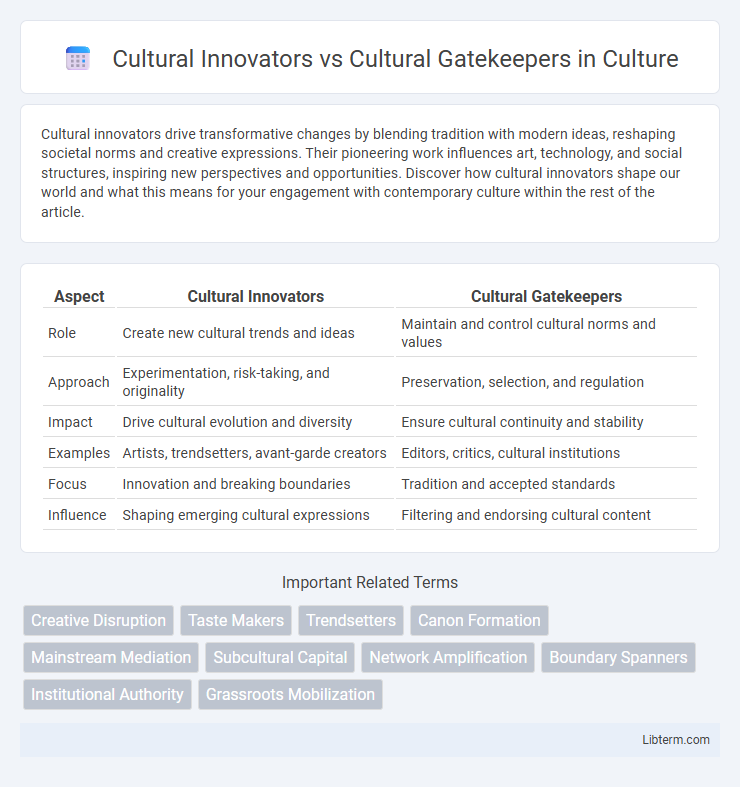Cultural innovators drive transformative changes by blending tradition with modern ideas, reshaping societal norms and creative expressions. Their pioneering work influences art, technology, and social structures, inspiring new perspectives and opportunities. Discover how cultural innovators shape our world and what this means for your engagement with contemporary culture within the rest of the article.
Table of Comparison
| Aspect | Cultural Innovators | Cultural Gatekeepers |
|---|---|---|
| Role | Create new cultural trends and ideas | Maintain and control cultural norms and values |
| Approach | Experimentation, risk-taking, and originality | Preservation, selection, and regulation |
| Impact | Drive cultural evolution and diversity | Ensure cultural continuity and stability |
| Examples | Artists, trendsetters, avant-garde creators | Editors, critics, cultural institutions |
| Focus | Innovation and breaking boundaries | Tradition and accepted standards |
| Influence | Shaping emerging cultural expressions | Filtering and endorsing cultural content |
Defining Cultural Innovators and Gatekeepers
Cultural innovators are individuals or groups who introduce original ideas, styles, or practices that challenge existing norms and drive social or artistic progress. Cultural gatekeepers control access to cultural resources, determine which trends gain visibility, and influence public taste by filtering and endorsing content. The dynamic between innovators and gatekeepers shapes the evolution and dissemination of cultural expressions in society.
Historical Evolution of Cultural Influence
Cultural innovators have historically driven transformative shifts in art, technology, and social norms by introducing novel ideas that challenge existing paradigms. In contrast, cultural gatekeepers, including institutions and authorities, have traditionally controlled which cultural expressions gain legitimacy and widespread acceptance through selective endorsement and dissemination. The dynamic tension between these roles has shaped the evolution of cultural influence, with innovators pushing boundaries and gatekeepers determining the preservation and dominance of certain cultural narratives over time.
Roles and Responsibilities in Shaping Culture
Cultural innovators drive transformation by introducing new ideas, art forms, and social practices that challenge existing norms, pushing the boundaries of cultural expression. Cultural gatekeepers, including institutions, critics, and media, regulate and legitimize cultural content, determining which innovations gain acceptance and visibility within society. Together, innovators and gatekeepers shape cultural evolution by balancing creativity with preservation, influencing public perception and cultural continuity.
Innovation vs Preservation: Conflicting Priorities
Cultural innovators drive progress by introducing new ideas and challenging traditional norms, emphasizing creativity and transformation to reshape societal values. Cultural gatekeepers prioritize preservation, maintaining established traditions and safeguarding historical legacies to sustain cultural continuity. The tension between innovation and preservation reflects conflicting priorities where progress often risks eroding heritage, while strict adherence to tradition may hinder adaptive growth and relevance in a changing world.
Key Examples of Modern Cultural Innovators
Key examples of modern cultural innovators include artists like Beyonce, who reshapes music and social activism through her multimedia projects, and tech entrepreneurs like Elon Musk, whose ventures in electric vehicles and space exploration influence global technological culture. Musicians such as Kendrick Lamar revolutionize hip-hop with profound social commentary, while influencers like Billie Eilish challenge traditional fashion and music industry norms. These innovators drive cultural evolution by blending creativity, technology, and social impact, setting new trends that gatekeepers often later adopt or regulate.
The Power of Gatekeepers in Traditional Media
Cultural gatekeepers in traditional media hold significant power by controlling the flow of information and shaping public discourse through editorial choices and content curation. Their influence extends to determining which voices and narratives gain prominence, often dictating trends and societal values within mass audiences. This control reinforces established cultural norms, limiting the reach of cultural innovators who challenge mainstream perspectives.
Societal Impact: Change Agents vs Status Quo
Cultural Innovators drive societal progress by challenging existing norms and introducing transformative ideas that foster inclusivity and diversity. Cultural Gatekeepers maintain established traditions and power structures, often reinforcing the status quo and limiting the scope for social change. The dynamic tension between these roles shapes cultural evolution and influences the pace at which societies adapt to emerging values and technologies.
Gatekeeping in the Digital Age
Cultural gatekeepers in the digital age control access to information and creative content through algorithms, platform policies, and content moderation, shaping public discourse and cultural trends. These gatekeepers include social media companies, streaming services, and online marketplaces that influence visibility and engagement for creators and audiences alike. Their role in filtering and promoting content significantly impacts diversity, representation, and the democratization of culture in an increasingly connected world.
Collaboration and Tension Between Innovators and Gatekeepers
Collaboration between cultural innovators and gatekeepers often drives the evolution of artistic and social movements, with innovators introducing groundbreaking ideas and gatekeepers shaping their acceptance within mainstream culture. Tension arises as gatekeepers may resist change to maintain traditional norms and power structures, creating a dynamic push-and-pull that influences which cultural expressions gain visibility and legitimacy. This interplay fosters a complex ecosystem where innovation challenges established frameworks, while gatekeepers ensure continuity and selective integration of new cultural elements.
Future Trends in Cultural Influence and Control
Cultural innovators drive the future trends in cultural influence by introducing groundbreaking ideas and technologies that reshape societal norms and consumer behavior. Cultural gatekeepers filter and control the dissemination of cultural content, often determining which innovations achieve mainstream acceptance or remain niche. As digital platforms and decentralized media evolve, the balance of cultural influence is shifting from traditional gatekeepers to more diverse and grassroots innovators, accelerating cultural democratization.
Cultural Innovators Infographic

 libterm.com
libterm.com